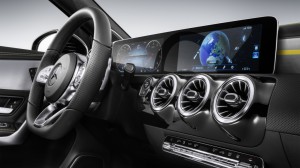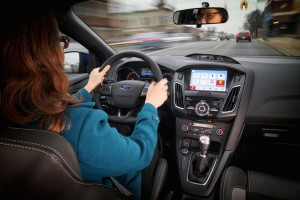The annual Consumer Electronics Show in Las Vegas has become a showcase for the auto industry, as much as it traditional was for computer, TV and smartphone manufacturers. A number of intriguing products, such as the Volkswagen BUDD-e van and Chevrolet Bolt EV have debuted there in recent years, but Mercedes-Benz is taking a different tack next month, using CES to reveal a completely new infotainment system.
Dubbed the Mercedes-Benz User Experience, or MBUX, it is designed to replace the German marque’s now-familiar COMAND system. Using artificial intelligence and what Mercedes calls “an intuitive operating system,” the goal appears to be finding a way to add even more technology into tomorrow’s luxury products without confounding owners.
That’s a major challenge. Today’s cars are loaded with as many as 100 different microprocessors operating such things as a vehicle’s engine and safety gear. But manufacturers are also loading up with lots of new infotainment technologies and in many cases, they can turn out to be “nightmares” to operate, Renee Stephens, vice president at J.D. Power and Associates noted when unveiling the research firm’s latest APEAL study earlier this year.
Balky navigation systems have become a particular headache, but consumers also routinely complain about faulty voice recognition systems and the various knobs, touchscreens and other devices used to operate the latest infotainment systems.
And that creates a conundrum for carmakers. Take Ford: the automaker has found that its Sync system has widespread appeal to tech-savvy millennials. But problems with the first two generations of Sync led to Ford taking a sharp tumble on quality and reliability studies, such as the Power Initial Quality Survey. Ford wound up breaking with Microsoft, which developed the initial infotainment package, turning to Blackberry, the company best known for its early smartphones, to develop the latest Sync 3 version.
Developing a good user experience for the automobile can be particularly challenging, experts say, because there are more and more features and functions being added to today’s cars. It can be a challenge to learn all the basic commands, and whether trying to use a knob, touchpad or touchscreen, that can be difficult in a vehicle bouncing down a rough road at 60 mph. Voice recognition systems have to adjust to a wide range of accents, from Southern drawls to nasal Northern twangs, as well as the speech of non-native English speakers.
Daimler isn’t saying much about the MBUX system, beyond noting in a press relative, “Featuring innovative technology based on artificial intelligence and an intuitive operating system, the MBUX is set to usher in a new era in terms of infotainment and Mercedes me connectivity. To ensure a pioneering in-car experience, the technology will be introduced as standard equipment in the next compact car generation as early as 2018.”
The image accompanying the Mercedes release shows the interior of the next-generation A-Class model which adopts the same sort of extended screen first seen on the big S-Class. That includes a reconfigurable virtual gauge cluster behind the steering wheel, and a widescreen infotainment display atop the center stack.
The latest S-Class – and other Mercedes models – attempts to give motorists a variety of ways to operate the various technologies onboard. That now includes not only the familiar COMAND knob on the center stack but a touchpad above it upon which a driver can do things like sketch in a number when programming an address or a phone number. And along with a touchscreen, a motorist can opt to use voice recognition.
Whether all those various controls will be available on the MBUX system isn’t clear. It also remains to be seen whether Mercedes will require that future models have access to the cloud to use its new AI system. That’s the way the iPhone’s Siri and Amazon’s Alexa operate, as the cloud can provide far more computing power than a standalone phone or even a vehicle. But that creates a potential problem when driving through a tunnel or into a big parking structure where signals can be lost.
We’ll have to wait until CES next month to see precisely how much smarter and easier to use the new Mercedes MBUX system really is.



